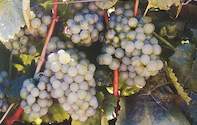Description
Bukettraube is an aromatic white cultivar originating in Germany from a hybrid of Sylvaner and Trollinger grapes. Ripening very late in Germany and susceptible to powdery mildew, the cultivar has almost died out.
Origins
GermanyOther Names
Bouquettrabe, Bukettrebe, Boxer, Riesling Bukett, Sylvaner Musque, Bukettriesling, Bocksbeutel, Wuerzburger.Production in South Africa
The first vineyards (recorded) were planted in 1978 on the farm Lemoenfontein near Paarl. Plantings have reduced from 280ha in 2000 to 52ha in 2016. The majority of Bukettraube (31.5ha) is found in the Swartland area.Production Regions
Only about 70ha of Bukettraube exists in the world, with about 68ha in South Africa (2014), mainly in the Cederberg, Paarl and Malmesbury areas.Growth and Ripening
The cultivar has a high yield, but is a slow weak grower. It is costly to grow due to high spraying costs. The grape is late ripening but this often leads to low acidity of 5-6g/l.